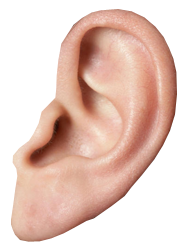
Q. and A. with Dr. Kiskila- This Month’s Topic: Ear Wax
 Question- Dr. Kiskila, what is ear wax?
Question- Dr. Kiskila, what is ear wax?
Answer- Ear wax (cerumen) is a natural lubricant that the ear produces which helps aid hearing conduction.
Question- How does ear wax occur?
Answer- As the body produces ear wax, it moves in the ear canal and eventually falls out. New wax production kicks the old wax out, but sometimes the old wax collects in the ear canal and causes wax build up or cerumen impaction.
Question- What are the symptoms of excessive ear wax build-up and how do I know if I have it?
Answer- Decreased hearing, ear fullness, pressure or irritation and ear discomfort are common symptoms of cerumen impaction. Ear wax buildup may occasionally present as ear pain. Cerumen impaction is identified by visual inspection of the ear ca nal with an ear scope called an otoscope. Obstruction due to ear canal disease, narrowing of the ear canal, overproduction of wax, or the failure of wax to migrate to the ear opening are other reasons cerumen impaction can occur.
nal with an ear scope called an otoscope. Obstruction due to ear canal disease, narrowing of the ear canal, overproduction of wax, or the failure of wax to migrate to the ear opening are other reasons cerumen impaction can occur.
Question- Does ear wax build-up negatively impact my hearing?
Answer- Cerumen accumulation usually causes no symptoms, but in some cases, if wax gets impacted it can lead to hearing loss, ear fullness, itching or pain. It can cause dizziness, vertigo, cough or ringing in the ear (tinnitus). Decreased hearing is often the most common symptom of cerumen impaction.
Question- What are the treatment options for ear wax removal?
Answer- Ear wax removal is not recommended for patients without any symptoms. For those with symptoms due to cerumen accumulation, ear wax drops can be used to soften the wax, and irrigation and mechanical removal with a curette or suction is sometimes used.
Question- How do I prevent getting ear wax?
Answer- For those who get recurrent wax build up, use an ear wax softening drop three times a week to soften the wax and aid in the normal elimination mechanisms. Patients with chronic impaction should be referred to an ear specialist (ENT), and so should people with perforated ear drums, history of ear surgery, ear discharge, necrotic tissue, or persistence of ear complaints after wax removal.
The information provided is for general interest only and should not be misconstrued as a diagnosis, prognosis or treatment recommendation. This information does not in any way constitute the practice of medicine, or any other health care profession. Readers are directed to consult their health care provider regarding their specific health situation. Marque Medical is not liable for any action taken by a reader based upon this information.
